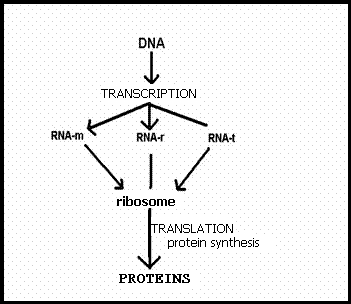Genetic information
We are not going to treat the biological process, but yes, in short, some chemical characteristics of the production of proteins in living creatures.
A summary:
The information stream goes from DNA to RNA (transcription).
The RNA, in its turn, translates her codes to the right protein (translation)
DNA
 (transcription)
(transcription)
 RNA
RNA
 (translation)
(translation)
 proteins
proteins
The base sequence of a gene (a part of DNA or RNA) goes paralel to the amino acid sequence of the product that this gene is going to make (a polypeptide / protein).
The gene code is fixed in the sequence of the bases (A, C, T en U) in such a way that every three sequencing bases determine one amino acid.
So, e bit simplified: if a gene has 600 bases, a protein of 200 amino acids can be produced. The word 'determined' in fact, is better here.
You must understand the great importance of starting the whole process at the right base.
There are even start (triplet)codes and stop codes (codons).
So there are four bases in the genetic material, in the genes, and with them you can determine 43 different amino acids.
But you know that in living creatures about 20 different amino acids are used, not 64.
Three are reserved for stopping and starting the production, but there are stil 41 left more than necessary.
In practice several codes can determine one and the same amino acid. Such codons are called: synonym codes.
You know that the protein molecule (also an enzym) is formed out of amino acids in a polycondensation process.
The function of proteins, in particular that of enzyms, is extremely important in living creatures, also for the metabolism. Any single mistake in such an enzyme can cause a stagnation in the metabolism, with the consequence of serious (inherited) abnormalities or even the end of life.
So the controll mechanism in the body, to secure the production of right proteins/enzyms is very good developed.
The information and the controll comes from the DNA that stays in the cell nucleus.
The DNA itself does not go to the cell plasma (to the ribosomes) to do that controll itself. It sends copies op itself (RNA, in a transcription process) outside, to the ribosomes, where also the amino acids arrive, to be connected exactly in the right way.
The next scheme shows more or less such a happening:

During transcription parts of DNA (genes) are copied (with almost the same four types nucleic acids).
During translatie, at the ribosomes, the amino acids (20 types) are connected to make proteins.


